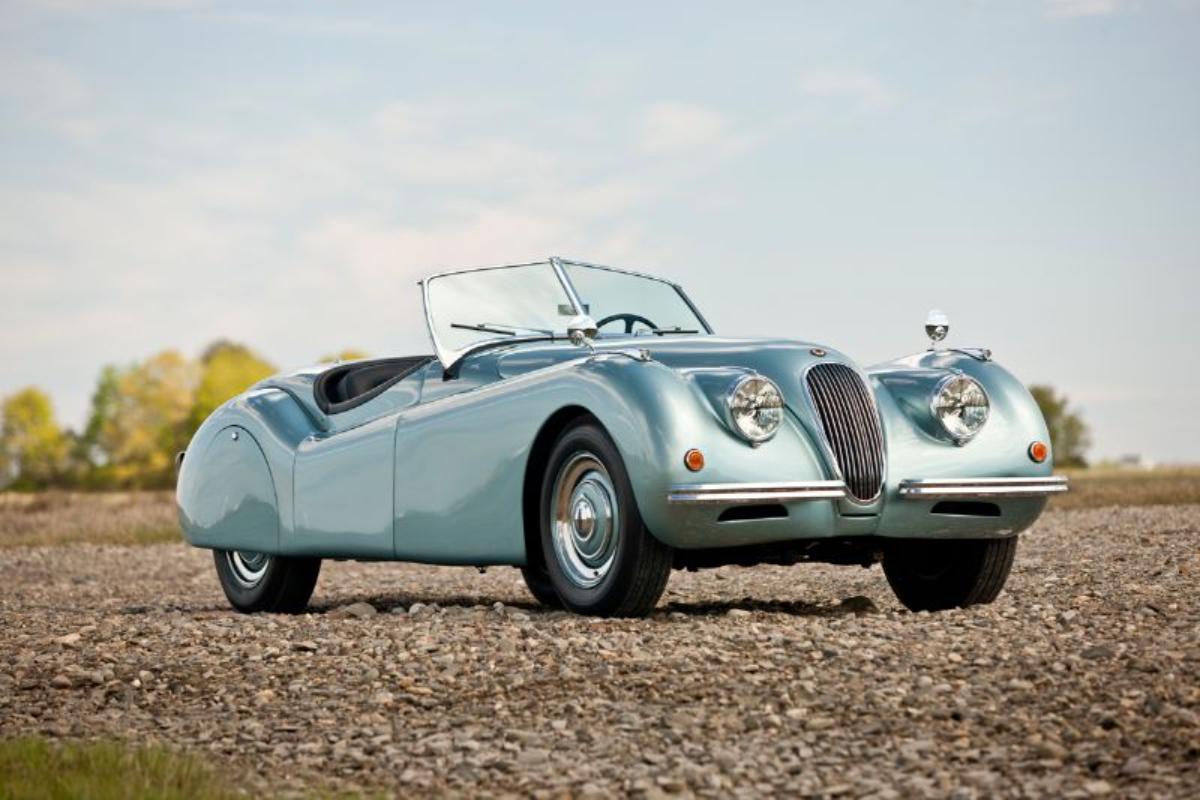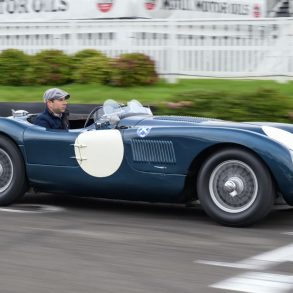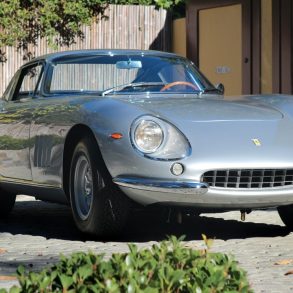The Jaguar XK120 is a testimony to the finest traits of British styling and engineering. Obtaining its name for its top speed of 120 mph, the XK120 was an elegant and technically innovative vehicle, with bragging rights of being the fastest production car of its time.
Conceptualized in a time of difficulty for Britain, the 3.4 liter, 6 cylinder Jaguar XK120 represented the greatest of modern design, possessing twin overhead camshafts operating in an aluminum-alloy cylinder head, with a maximum output of 160bhp.
What started as a limited production of 200 cars, ended with a production of over 12,000 vehicles, many shipped to the USA to provide valuable export dollars to a country still recovering from WWII.
The Origins of the XK120
Prior to World War II, Sir William Lyons had declared his objective to create one of the world’s most exceptional luxury cars, with a full-size saloon body and be capable of speeds of 100 mph.
His aspirations were temporarily disrupted by World War II, during which his company, S.S. Cars Limited, was focused on the construction of war material, and in particular, they fixed aircraft as well as providing sidecars and trailers to the armed forces.

Despite Coventry’s factories being targeted by the German blitz, Lyons’s ambitions remained steadfast. In the midst of the war, Lyons would meet with Bill Heynes, Walter Hassan, and Claude Baily during fire watching duties at the Foleshill Factory in Coventry to talk about designing a new post-war engine. It is claimed that Jaguar’s wartime engine advancements went further than just ‘talking’ and designing but they progressed into constructing and trialing of various prototype engines as early as 1943.
In March of 1945, a general meeting took place amongst the S. S. Cars shareholders to vote on changing the company’s name to Jaguar Cars Limited.
“Unlike S. S. the name, Jaguar is distinctive and cannot be connected or confused with any similar foreign name.”
Chairman, William Lyons
At the conclusion of the war, a greater focus could be placed on the new engine which Lyons originally desired for a new range of saloons. Lyons recognized there were higher profits to be made with the high-volume sales of saloon cars and envisioned a period of austerity after the war with a greater interest in smaller engines. Consequently, both four and six-cylinder variants were conceived.
XK Engine
Engineers under the leadership of brilliant technical director William Heynes were aiming to finish their first post-war project being the development of the new X-Series engine.
Fuel economy issues at the time were making large engines impractical, so they concentrated instead on specific output, getting the greatest power out of a modest displacement. Bill Heynes heavily pushed for dual overhead camshafts that had shown success on the racetrack but were seldom seen on street cars due to their complexity and significant expense.

The initial XK engine, a four-cylinder unit, was not run until October of 1945. It consisted of a three-bearing crankshaft, a bore and stroke of 76 x 98 mm along with a capacity of 1,790 cc. During early trials, the four-cylinder unit produced an output of 76 bhp. By testing the engine, it allowed them to develop the overall design which consisted of:
- twin overhead cams
- two valves per cylinder
- hemispherical combustion chambers
- polished cam covers
- fuelled by twin SU carburettors.

Also developed was a six-cylinder version with a bore and stroke of 83 x 98 mm with a capacity of 3,182 cc. The six-cylinder version was found to be smoother than the four-cylinder, so work continued by focusing on the 6-cylinder version.
Following experimenting with various configurations, the designers chose a six-cylinder version with the stroke increased to 106mm to give a swept volume of 3,442 cc that produced a staggering 160 bhp.
First Post-war Motor Show
Despite Lyons having a dynamic new engine, he was in an unusual position where he had no car to put it in. Work on the monocoque for the Mark VII saloon was taking much longer than anticipated and it would not be ready for the first post-war Motor Show in 1948. Instead, a choice was made to display the engine in a new sports car.
Lyons went on to design a suitable body that would match a shortened Mark V chassis. With the aid of Fred Gardner, the XK120 was designed and constructed within months. The XK120 design was sleek, modern with an elongated hood.

The pre-production XK120 display car, chassis number 660001, was introduced at the 1948 London Motor Show at Earls Court on the 27th of October. The automotive community was in awe at its beauty and power- a car that was capable of over 120mph and costing just £1263.
At the same time, its competitors were principally displaying sports cars still inspired by pre-war design and technology. The XK120 Jaguar swiftly become the world’s most desired car. The timing of its release was perfect, with the US desperate for British sports cars post-WWII and the British Government in need of export dollars.

The XK120 was intended as a limited production model that would exhibit the new XK engine before it went into full production with the Mark VII saloon. To Lyons’s astonishment, the response was so popular that Jaguar couldn’t keep up with demand, and the concept to produce only 200 was blown away.
The demand for XK120 was so high that to go full production they required a switch from aluminum-over-ash to steel for the predominant bodywork in April 1950.

The range was also expanded, with the fixed-head coupé released in 1951 and the drophead coupé in 1953.
In 1949 the first production car, chassis number 670003, was purchased in the US by “The King of Hollywood”, Clark Gable.

In total, 12,061 XK120s were constructed between the years 1949-1954 with most exported internationally where the XK120 promoted Jaguar as one of the chief imported names.
A breakdown of the production numbers for each variant are as follows:
| Total Produced | |
|---|---|
| XK120 (aluminum) 1949-1950 | 242 |
| XK120 Roadster 1950-1954 | 7631 (includes 242 aluminum body cars) |
| XK120 Fixed Head 1951-1954 | 2678 |
| XK120 Drop Head 1953-1954 | 1769 |
Jaguar XK120- Fastest Production Car
In May 1949, to convince the critics regarding the vehicle’s speed, Jaguar chose to show the newly launched XK120 roadster to members of the press on a stretch of autoroute between Jabbeke and Aeltre in Belgium.
In Belgium, the press was taken to a placid section of the motorway to watch test driver Ron ‘Soapy’ Sutton unleash the capabilities of the car. Ron used a white left-hand drive car, chassis number 670002, which was the second XK120 ever built.

With the only specialized equipment the XK120 had was an under-shield and a racing windscreen (both were factory options), Sutton was able to reach a speed of 132.6 mph over a flying mile. With the hood and side screens erected, along with the standard windscreen, a speed of 126 mph was achieved. To illustrate that the car was no race-special, Ron then proceeded to idle past the crowd at 10 mph in top gear. This feat cemented the Jaguar XK120 was the fastest production car in the world.
The XK120 record was preserved until September 1953 when Celso Fernandez, driving the new Z-102 Touring model from Spanish company Pegaso, shattered four official Royal Automobile Club of Belgium records. One of these was the flying kilometer at a speed of 151.042 mph (243.079 km/h).
On discovering the record-breaking news, Lyons promptly contacted Norman Dewis, Jaguar’s principal test engineer, and questioned Dewis what he would do about it.
Norman was skeptical about further optimisation of the XK120, but nevertheless, the team returned to Jabbeke in October. The vehicle they took was a rally outfitted car, registration MDU 254. Only minor modifications had been performed to its powertrain and aerodynamics.
The modifications included:
- a higher compression ratio
- close-ratio gearbox and heavy-duty prop shaft
- a full undershield
- removal of the side and rear light
- a metal tonneau cover
- streamlined headlamps.

The most exceptional characteristic was a Perspex ‘bubble’ cockpit canopy which was bolted down upon Norman entering the car – something that also required removing the driver’s seat and leaving Norman with just a slim piece of foam.
The car had almost slick tires with only 2mm of rubber remaining on them. They were inflated to 50psi to reduce drag.

On the day to everyone’s delight, Dewis broke the Pegaso record with a top speed of 172.4 mph (277.47 km/h) that was verified by the Royal Automobile Club of Belgium, returning XK120 to once again the fastest car in the world status.
Design of the XK120
The outline of the XK120 has a resemblance to the Touring-bodied BMW 328s that ran in the 1940 Mille Miglia.
The XK120 is longer, lower, and much more curvaceous than the BMW. One of the most prominent features is the dramatic beltline dip below the doors.

The front features a narrow ribbed grille which adds to the XK120s elegance and chic. The narrow grille however wasn’t the best choice for optimal engine cooling.

The front also features round headlights that are beautifully connected to the rest of the car. The rear of the XK120 features a gradual and smooth drop toward the rear round backlights.

Specifications of the XK120
| Engine Location | Front, in-line |
| Configuration | Six-cylinder |
| Valve Operation | Twin Overhead Camshafts |
| Bore and Stroke | 83 X 106mm |
| Capacity | 3442cc |
| Transmission | Four-speed Manual |
| Front Suspension | Wishbone and torsion bar |
| Rear Suspension | Half-elliptic spring |
| Brakes | Drum |
| Horsepower | 160 bhp @ 5500rpm |
| Acceleration | 0 -60mph in 12 seconds |
| Top Speed | 120mph |
Versions of the XK120
XK120 Open Two Seater Roadster
The first version of the XK120 was known as the OTS, which stands for Open Two Seater or more commonly known as the “Roadster”. The initial design utilized an aluminum body over an ash and steel frame. Due to unanticipated demand, production moved to steel-bodied cars.



XK120 Fixed Head Coupe
The second version of the XK120 was unveiled in 1951. The new version featured a fixed steel roof and was called the Fixed Head Coupe. The Fixed Head Coupe was a more practical version of the XK120 with winding windows and a walnut veneered dashboard.




Jaguar XK120 SE Roadster
The FHC was not the only version revealed in 1951, along with it, Jaguar introduced the Special Equipment (SE) version. The team of engineers at Jaguar was still able to obtain greater performance from the world’s fastest production car.
The SE version modifications included high-lift camshafts, stiffer rear springs, dual exhausts, and a lightened flywheel. These improvements enabled the 3.4-liter straight-six to deliver 180 horsepower, an additional 20 horsepower over the original XK120’s output. The addition of wire wheels also had an exceptional impression on the car’s overall look.

Jaguar XK120C
In the same year, they also introduced a new variation of the XK120, called the XK120C, or “C-Type.”

Although the C-Type and XK120 had a similar power train, the C-Type had a rather different chassis and body.
An innovative tubular design engineered by Bob Knight from 16-gauge tubing was utilized instead of the steel ladder-type frame.
A new curvaceous aluminum body that was designed by aerodynamicist Malcolm Sayer overlayed the new chassis.
The C-Type variant had an output of around 205 bhp. The early C-Types were outfitted with SU carburetors and drum brakes. Succeeding C-Types utilized triple twin-choke Weber carburetors and high-lift camshafts.
A total of 53 C-Types were constructed which resembled the works racers of 1951. 43 of these were sold in the USA.
Jaguar XK120 Drophead Coupe
The final version of the XK120 was introduced in 1953. It was called the Drophead Coupe, or DHC in short. The Drophead Coupe gathered the best of both worlds. It retained the original open roadster’s lines while providing practicality and refinement in relation to its wind-up windows, heater, opening quarter lights, enhanced ventilation, and a permanently connected Mohair-lined hood.

Valuations of the XK120
1949 Jaguar XK120, Alloy Roadster
| Condition | Value |
|---|---|
| Concours | $385,000 |
| Excellent | $315,000 |
| Good | $212,000 |
| Fair | $190,000 |
1950 Jaguar XK120 Roadster (Steel-bodied)
| Condition | Value |
|---|---|
| Concours | $154,000 |
| Excellent | $132,000 |
| Good | $86,000 |
| Fair | $63,900 |
1952 Jaguar XK120, Fixed-Head Coupe
| Condition | Value |
|---|---|
| Concours | $152,000 |
| Excellent | $107,000 |
| Good | $78,400 |
| Fair | $51,900 |
1953 Jaguar XK120 Drophead Coupe
| Condition | Value |
|---|---|
| Concours | $159,000 |
| Excellent | $124,000 |
| Good | $86,700 |
| Fair | $58,300 |
1952 Jaguar C-Type 2dr Roadster
| Condition | Value |
|---|---|
| Concours | $6,000,000 |
| Excellent | $5,000,000 |
| Good | $3,100,000 |
| Fair | $2,500,000 |
Racing and Rallying Highlights
The XK120 was the perfect package for a race car, it was swift and reliable. Without a surprise, it was highly successful in both road racing, endurance events, and even rallying.
The XK120 collected its first win in 1949 at the Silverstone Circuit in England. Besides the winning XK120 driven by Leslie Johnson, another driven by Peter Walker took second place.
By the time the 1950s rolled around, the XK120 collected its first win internationally. With Johnson behind the wheel, it scored a win in the production class in Palm Beach Shores, Florida. Despite major braking issues it still finished fourth overall.
The best results of that year included fifth place at the famous Mille Miglia race. Fifth place was an amazing achievement for a production car. It was only beaten by the likes of Fangio’s works Alfa Romeo and the works of Ferrari.
The XK120 also competed in the famous Sicilian Targa Florio and the Tourist Trophy. Jaguar had a sensational outcome in the Tourist Trophy where three XK120s scored an impressive 1-2-3 victory. The winner of the race was Stirling Moss, who achieved this victory on the eve of his 21st birthday.
1951 Le Mans Win
Numerous privateering customers registered factory-supported XK120 models at the 1950 Le Mans race, and Leslie Johnson’s car was exceptionally competitive, spending substantial time in 4th place.
After watching the event, Lyons and Heynes were satisfied that a lighter, more aerodynamic body with modified XK120 mechanics had a powerful opportunity of winning the race.

Development work soon commenced on an innovative lightweight tubular space frame, one of the earliest applications of the technique in sports car development.
The XK120’s rear suspension was redesigned with extra positioning links, and the 3.4-liter XK engine output was boosted to 200 horsepower by acquired a new cylinder head, high-lift camshafts, racing pistons, and an un-muffled dual exhaust system.



In addition, the car took on new coachwork: a fluid aerodynamic combination of curves and bulges created by stylist Malcolm Sayer.
Originally known as the XK120C (C for competition), the C-Type, made its first appearance at Le Mans in 1951 with a team of factory-sponsored cars. Although two of the three ‘entries retired with oil line problems, Peter Walker and Peter Whitehead’s car succeeded in overall victory.

This was a momentous occasion for Jaguar as they were the first British car to win at Le Mans for 20 years. Their win was convincing, finishing 77 miles ahead of the 2nd place finisher and breaking multiple records:
- fastest lap speed of 105.232 mph
- 24-hour speed record of 93.495 mph
- Furthest distance traveled in 24 hours at 2,243.886 miles.
Rally Victories in the XK120
The Jaguar Xk120 had great success in rally events, most notably with the XK120 that was privately owned and campaigned by Ian Appleyard, with wife Patricia, William Lyons’ daughter, acting as navigator.
Although Appleyard narrowly missed victory by a quarter of an inch in the inaugural Tulip Rally in 1950, they were triumphant in the 1950 Alpine Rally.


1951 would see Appleyard have further success by winning the Alpine Rally once gain along with the RAC Rally and Tulip Rally.
Although they were not victorious in their third Alpine Rally in 1952, they were awarded the first-ever Gold Cup for racing three years in a row without incurring a single penalty point, an achievement awarded to only two other men, Stirling Moss and Jean Vinatier.
What started as a display car for the new XK engine became what we think to be one of the most unanticipated success stories in automotive history. The newly conceptualized XK120 was an inspiration to the post-war automotive industry. This XK120 proved to the world that Britain had the technical capability and determination to produce a stunning and innovative world-class sports car.











As a collector it’s amazing to me that these cars, even restored are so cheap. The XK140 was essentially the same but was better mechanically with more leg room. Only 2900 drop head XK140’s were made before the factory burned down – a wise collectable investment in my world. These cars created the modern sports car.
My XK140 has been in the family since 1965.When I started a rebuild of all things mechanical, I didn’t prepare for the level of organization involved.I never anticipated the long delays involved.Unforseen things, like moving to new locations,at the same time providing security and safety from theft.40 yrs. later, i’m almost nearing completion.I convince myself that this is not un-common of do-it yourselfers.Good luck to all.40yr.gvsdrvr7917
I had an xk120 1960 for several years in CT. I loved the car and the speed of it